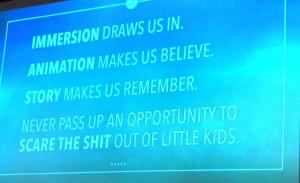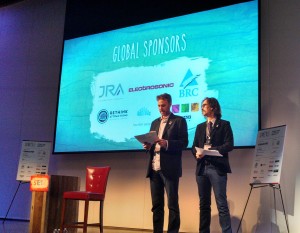 The halls of Savannah College of Art and Design (SCAD) literally shook last week, pulsating with the energy of the Themed Entertainment Association’s 9th Annual Storytelling Architecture Technology Experience (SATE) Conference. TEA President, Christine Kerr, and SATE Co-Chairs, exp’s Aram Ebben and Stefan Lawrence of Stefan Rules!, assembled a powerhouse slate of speakers for the nearly 200 attendees, and the conference offered 2 days brimming with presentations, roundtables and informal informational exchanges. The presenting sponsor of the conference was Christie®.
The halls of Savannah College of Art and Design (SCAD) literally shook last week, pulsating with the energy of the Themed Entertainment Association’s 9th Annual Storytelling Architecture Technology Experience (SATE) Conference. TEA President, Christine Kerr, and SATE Co-Chairs, exp’s Aram Ebben and Stefan Lawrence of Stefan Rules!, assembled a powerhouse slate of speakers for the nearly 200 attendees, and the conference offered 2 days brimming with presentations, roundtables and informal informational exchanges. The presenting sponsor of the conference was Christie®.
While the conference was segmented into the four component’s of SATE’s acronym, story was the wellspring and foundation of each: from how stories are conceived and constructed, to how they are manifested into a physical space, to who should be scripting them. Adam Bezark of The Bezark Company launched the Storytelling segment of the conference by reminding the audience that:
Armed with these words of wisdom, three presenters, each with strikingly divergent entertainment backgrounds, took the stage to offer their own perspectives of story. To the delight of journalists everywhere, Chicago Tribune reporter Mark Caro revealed that, in a world of nanosecond sound bites and 140-character tweets, a demand for long form writing has resurfaced. He pointed to articles such as Pitchfork’s recent Daft Punk interview to demonstrate how text can interweave with multimedia to produce dramatic journalistic results. “People are attracted to characters with complexity,” he said, and creating that complexity means making the audience use their imagination and do some of the work. Citing such examples as Sleep No More, an immersive, interactive version of Hamlet produced by NYC company Punchdrunk in 2011, Caro proclaims that if the fourth wall hasn’t been bulldozed completely, it’s recently had a few solid chunks removed.
Academy Award-winning software developer, Chris Huntley of Write Brothers, Inc. followed Caro by breaking down the essential components of story. His story development software, Dramatica, has become a secret weapon for Hollywood screenwriters, its central tenet being the Grand Argument Story. More complex than a simple beginning-to-end tale, the Grand Argument Story is comprised of five components: an inequity, a goal, a consequence, four distinct throughline stories (Overall, Main Character, Influence Character and Relationship) and an optimal resolution. These minimal elements of a story-driven themed entertainment product engage the guest by harnessing the philosophy of stories as models of human psychology. The Grand Argument Story can be used as the basis for an attraction’s marketing, pre-show, post-show and sequels and can connect the attraction to other entertainments.
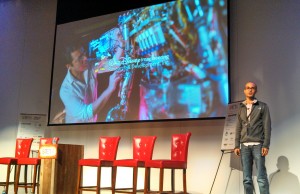
At Walt Disney Imagineering (WDI) researchers are investigating ways in which the guests can author their own story experiences. To demonstrate, Asa Kalama, Creative Director for WDI Research and Development, showcased his recent project, “Legend of the Fortuna,” a long-form, pirate themed role-play in which selected guests interact with physical clues, mobile media, costumed actors and other guests as they maneuver through the various Disney parks in search of buried treasure. His greatest take away from the experiment? The role-play did not need to be so scripted. “Guests are spectacularly creative,” said Kalama. They will come up with their own scenarios and become the proprietors of the story. In the process, Kalama found, they will create deeper connections with each other, a stronger understand of self and a shifted perspective on the world around them. Kalama did not disclose a launch date for these role-playing experiences but said that WDI’s research on them was ongoing.
David Misch, comedic screenwriter and author of Funny: The Book, rounded out the Storytelling segment. Through his career of writing for such shows as Mork and Mindy and SNL, Misch learned that “there is not an aspect of comedy that doesn’t apply to drama. It’s the attitude that makes something funny, not the content.” He offered vignettes of Groucho Marx and Abbott and Costello as examples: we see them get kicked, punched and tripped, and all we want to do is laugh. Following his presentation, Misch joined his fellow panelists and other industry creatives at “The Writer’s Table,” participating in such jovial discussion topics as why themed attractions aren’t funny and the potential benefits of adding a horror component to “It’s a Small World.”
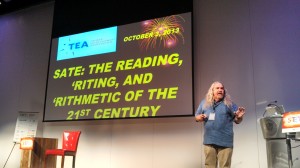
Before moving onto the Architecture portion of SATE, Don Marinelli, the retired Carnegie Mellon professor nicknamed “The Tornado” by his industry peers, blew onto the stage with his keynote, “SATE: The Reading, ‘Riting and ‘Rithmetic of the 21st Century.” The co-founder of CMU’s Entertainment Technology Center with Randy Pausch (The Last Lecture), Marinelli began by admitting that he “didn’t know sh[*]t about tech” and that his “entire career has been about how to figure out young people.” He then profiled what he called the “21st Century Digital Natives” – the technophile generation of “whole-brain thinkers” that has grown up in a time of unprecedented technological evolution. Calling SATE “the curriculum of the 21st Century,” he challenged traditional institutions – including colleges, universities and museums – to adapt to this increasingly participatory cultural environment or risk becoming obsolete. The next generation has an unyielding sense of possibility and heightened expectations of the future, and traditional institutions and storytelling methods either need to get on board or get out of the way. Marinelli’s presentation particularly resonated with the large number of student and recent graduates in attendance, members of TEA’s NextGen initiative (read more about the TEA NextGen component on the SATE ’13 blog).
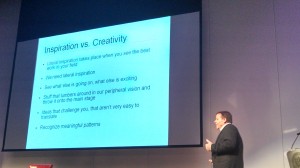
The extremely difficult task of serving as the calm after the Marinelli storm fell upon the Architecture panel, curated by PGAV Destinations’ Al Cross. Jonathan Douglas of VOA Orlando presented first in Cross’ line-up, comparing the craft of designing a building to the art of developing a film. For both creative genres, the end goal is for the product to be conceived as an emotional event and constructed as a multisensory experience. He tasked the audience to draw from what is exciting around them and to embrace challenging ideas, to take “the stuff that lumbers around our peripheral vision and throw it onto the main stage.”
Following Douglas’ remarks, Cecil Magpuri offered recent project examples of how his company, Falcon’s Treehouse, interprets story through architecture: “most of our clients have a ‘haiku’ of a story and need Falcon’s Treehouse to draft a story for them.” Through storyboarding and concept design, Falcon’s Treehouse develops this haiku into a total attraction package. Inventor Chuck Hoberman, the man behind such marvels as the Hoberman Arch at the 2002 Olympics and the expanding video screen for U2’s 360° World Tour, discussed the history behind his engineering marvels, before concluding that “creativity lies somewhere between art and science.” Following the Architecture panel, the day concluded with a presentation on SCAD’s Collaborative Learning Center, a triumvirate partnership of students, professors and some of the world’s top companies. SATE attendees then made their way to Habersham Hall, a converted jail now used as a SCAD event space, and were treated to a medley of Johnnie Mercer tunes performed by SCAD theater students.
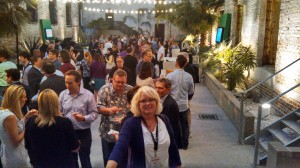
Day Two began by showcasing the latest and greatest in themed entertainment technology. Curated by Mk Haley of WDI Research, the panel commenced with Electrosonic’s Paul Kent and Chris Conte, who offered a brief history of themed entertainment lighting before prophesying what they believed to be the technology of the future: laser illumination projection. Promising better light uniformity, a higher contrast ratio and color gamut, a smaller projector head and longer life than LED, laser illumination projection promises to optimize 3D, while simultaneously changing Chris Conte’s life: “filmmakers and show designers will love me!”
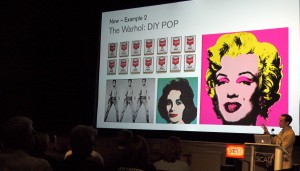
Following this illuminating presentation, Disney’s Jason Hintz Llopis demystified the “Now and Next in Interactive Technology”, assuring audiences to “fear not: it’s like a tasty pie.” Mark Gilicinski of MobileXpeditions procured the first slice, reminding the attendees “all tools need to be in the service of story,” be they wearable computing, sensors or hardware. He lists among the now and next those innovative technologies with modest budgets, consumer-based applications, mass personalization and location-based tools. Building on Gilicinski’s presentation, Joshua Jeffery demonstrated the various tools The Warhol Museum is employing to help guests tell their own stories. With DIY Pop, visitors can snap a photo and apply their own Warhol-esque treatment to it before sharing their images with friends via social media. The museum’s “Create Your Own Screen Test” interactive enables guests to film screen tests similar to those Warhol created at The Factory in the 1960s. DIY Pop and Screen Test are examples of how technology can allow guests to author their own stories and drive their own experiences.
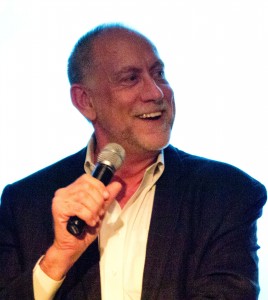
Experience, the penultimate combination of storytelling manifested into architecture and aided by technology, served as the final segment of SATE. Curated by Phil Hettema of the Hettema Group, the segment took off on the wings of Dave Cobb’s inimitable energy. In his presentation, “Cosplay Colonists – Rise of the Creative Audience,” Thinkwell’s Cobb cautioned, “if you think geeks are people who just sleep in their parents’ basement, you don’t understand the internet.” Declaring, “the audience has a compelling story of its own,” he pointed to the undeniable success of the gaming industry, which realized that having gamers create games is essential and thus embraced the concept of open-source, gamer-driven software development. The same user-conceived content model is already happening at parks, whether the parks realize it or not. At Universal’s Wizarding World of Harry Potter, a group of middle schoolers have made a habit of cosplaying their homework, tackling their 3 R’s in full Hogwarts regalia. Undeterred by Disney Parks’ restrictions on guests in costume, sites such as DisneyBound offer ideas for crafting fashion ensembles reminiscent of Disney characters, building a sense of community among avid park-goers in the process. “People will use your theme parks in ways it wasn’t designed for,” asserted Cobb. “Fans have a sense of ownership over your product that can be even greater than your own.”
Following Cobb, Jake Barton of Local Projects, the company behind the stunning “Gallery One” suite of new interactives at Cleveland Museum of Art, explained how technology and improvisation intersect to generate engaging experiences. Barton argued that the keys to improvisation are an openness to the process, the ability to make compelling statements, and the realization that there are not mistakes, only opportunities. While “technology has a short shelf life”, Barton argued, “human connection and emotion age well.” Gallery One brings Barton’s tenets to vibrant life, enabling guests to digitally discover all 3,000 of CMA’s works of art and interact with the pieces in groundbreaking ways.
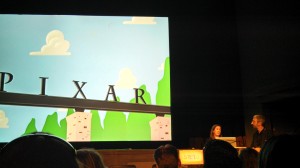
SATE came to a rousing conclusion with the help of Pixar Animation Studios’ Liz Gazzano and Roger Gould. Their keynote, “Pixar in the Parks”, chronicled how the animated movie Cars was translated into “Cars Land” at Disney’s California Adventure (DCA). Cars Land represented the first time that an entire story was transformed into a theme park environment, and Gazzano and Gould relished the opportunity to take the characters beyond the boundaries of the film. One of the greatest challenges was figuring out where the people fit in, as there are no humans in the cinematic world of Radiator Springs. “I don’t know what happened to them,” joked Gould, “but it wasn’t good.” Painstaking research went into re-creating the sights and sounds of the Route 66 corridor. Gazzano recalled loads of “iteration and plus’ing”, and the duo spent a substantial amount of time pitching ideas to everyone within Pixar, not just the top brass. The result? On opening day, a guest, whose property neighbored DCA, cornered Gould in tears. Not knowing who he was, she just grabbed the first person that would listen, exclaiming, “I’ve spent the last three years looking over the fence and waiting for this day. When they took the fence down, I cried.” But perhaps the greatest compliment Gould and Gazzano received was from a young boy, who upon seeing Radiator Springs in its recreated glory jubilantly squealed, “IT IS REAL!” Gazzano and Gould closed with three points of advice:
- Use technology to tell stories
- Create experiences and memories for people of all generations
- Have FUN!
SATE offered heavy dose of just that, and industry veterans and newbies alike tendered abundant praise for the TEA conference. Bezark dubbed it “amazing” and felt it exceeded his already lofty expectations: “For me, SATE ’13 was proof of the theorem that good deeds multiply exponentially. I was dazzled by the efforts put into the SATE presentations by everyone concerned. What I wasn’t expecting was the incredible outpouring of ideas, enthusiasm and appreciation that came back to us from our delegates. The seasoned pros were full of collaborative energy and fantastic insight.” Through SATE, Al Cross again “found new friends, deepened my friendships with old ones and found new avenues down which to travel.” And TEA NextGen Chair, Kile Ozier, rated the conference “pretty darn fantastic. The content, collectively, surpassed expectation and took the concept great leaps forward toward an edgier feel and focus on the future. Can’t wait to see where the momentum takes us.”
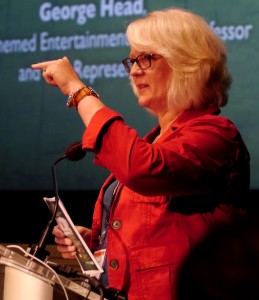
Based on the above accolades, if hosting the 9th Annual SATE conference at an academic institution for the first time was a risk, it was a risk that paid off, potentially resulting in a new model for future conferences. “This year’s SATE set a new bar for us, both from a content point of view and from a structure and organization of information perspective,” said Kerr. “And then of course we add charismatic and knowledgeable conference and segment chairs and we have a winning combination. When these things all work together (and we toss in an inspiring setting and the enthusiastic students) we have hit on a winning formula.”



